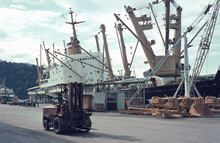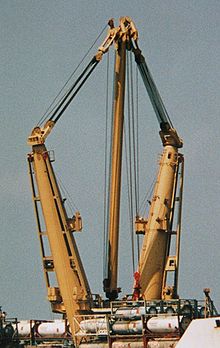Stülcken heavy lift tree
The Stülcken-heavy lift , also Stülcken mast , or Stülcken-Schwergutgeschirr called, is one from 1954 on heavy lift used Schwergutgeschirr .
history
The heavy-lift loading gear used by shipping companies such as the Norwegian Belships or the Bremen shipping company DDG “Hansa” from around the end of the First World War was labor-intensive and time-consuming. At the beginning of the 1950s, the designer Sprengel of the Hamburg Stülcken shipyard , in cooperation with the shipping company DDG "Hansa", especially with its nautical inspector Meybohm, developed a new type of heavy lift gear that was more efficient, faster and easier to set up than conventional contemporary systems. The ships of the Lichtenfels class built for the “Hansa” from 1953 onwards were the first of their kind with the new “Stülcken crockery”, which had a priority position worldwide for several decades. Over the years, the shipyard continued to develop the heavy lift booms in order to simplify the initially very demanding operation and to increase the lifting capacity. The most powerful telescopic masts were ultimately able to handle up to 350 tons in a single lift. After the bankruptcy of the Stülcken shipyard in 1966, the Blohm + Voss shipyard took over the construction and sale of the trees. In June 1970, the ship SA Vergere received its 250th stilting boom and in the course of the 1980s the construction of stilting boom ended, because equally powerful but more flexible ship cranes had been developed.
technology

The Stülcken crockery was characterized by a number of advantages. Due to the design-related omission of the shrouds and rails required for conventional loading booms and the high-mounted controllers, it was easier to operate. The relatively simple structure of the basic construction made it possible to be ready for work quickly. If several working hours were to be estimated for rigging conventional dishes, in the best case scenario a cantilever mast could be operational within a quarter of an hour. Cantilever harnesses allowed the boom to be swiveled through, which enabled two hatches to be operated. To make this possible, the tip of the cargo boom was designed in a fork shape and allowed the cargo block troughs to tip over . The V-shaped arrangement of the cargo posts were usually designed as fan shafts for the cargo holds and also made it possible to stow cargo next to the posts on deck, which was particularly advantageous when taking over particularly long packages . It was also possible to swing the load from one side of the ship to the other.
literature
- Hans Georg Prager : DDG Hansa. From liner service to special shipping . Koehlers Verlagsgesellschaft, Herford 1976, ISBN 3-7822-0105-1 .
Individual evidence
- ↑ The 250th Stülcken mast . In: Hansa . Vol. 107, No. July 14 , 1970, p. 1229-1231 .

